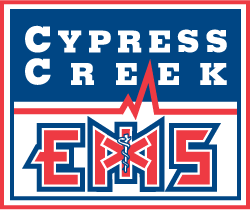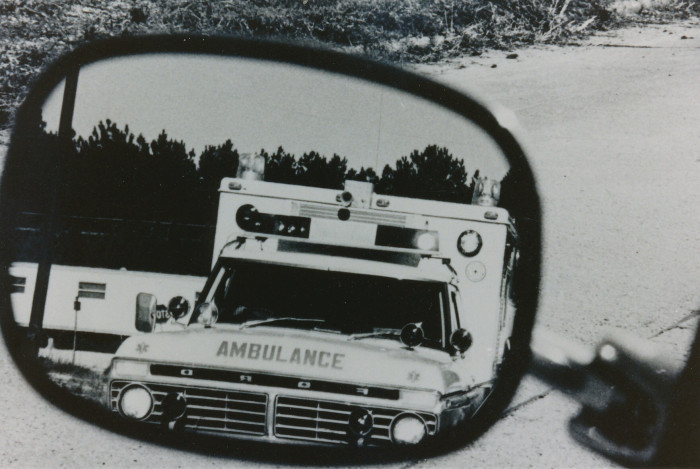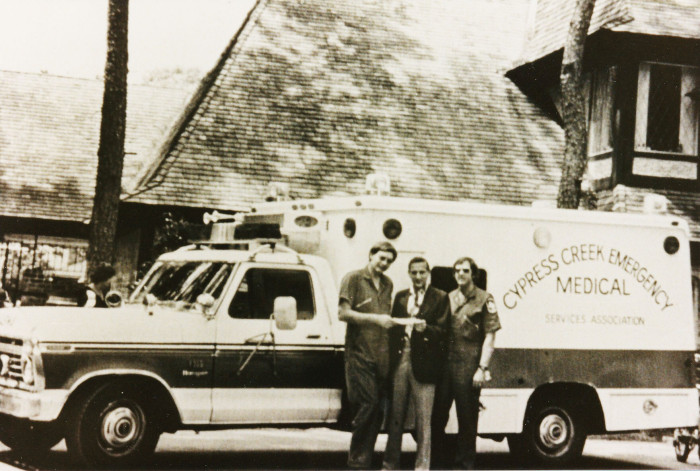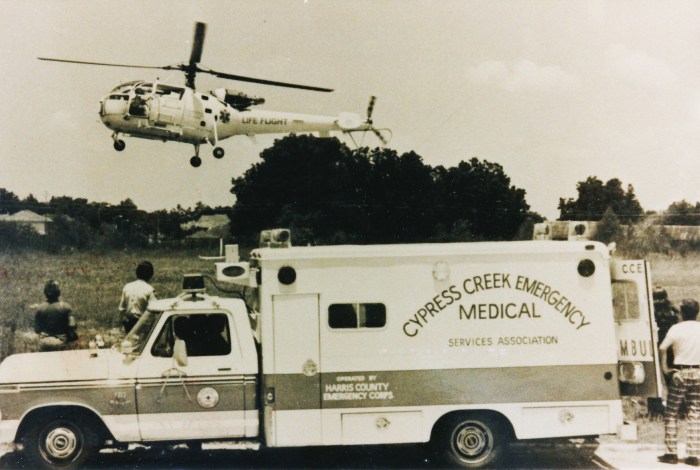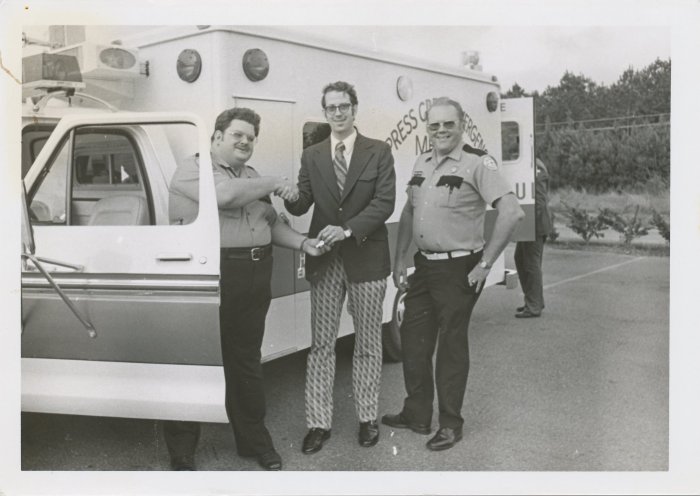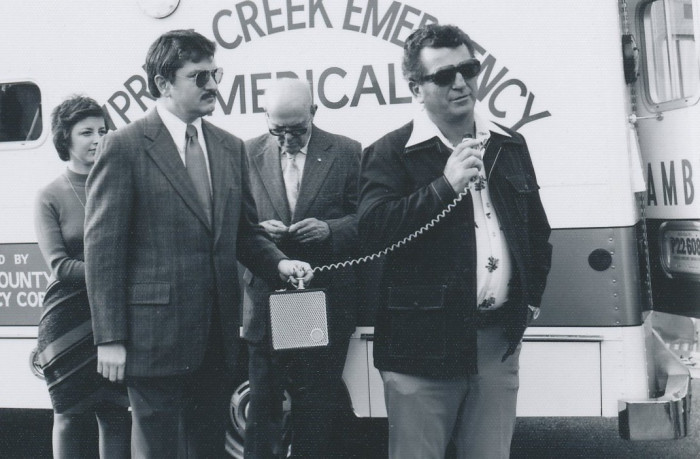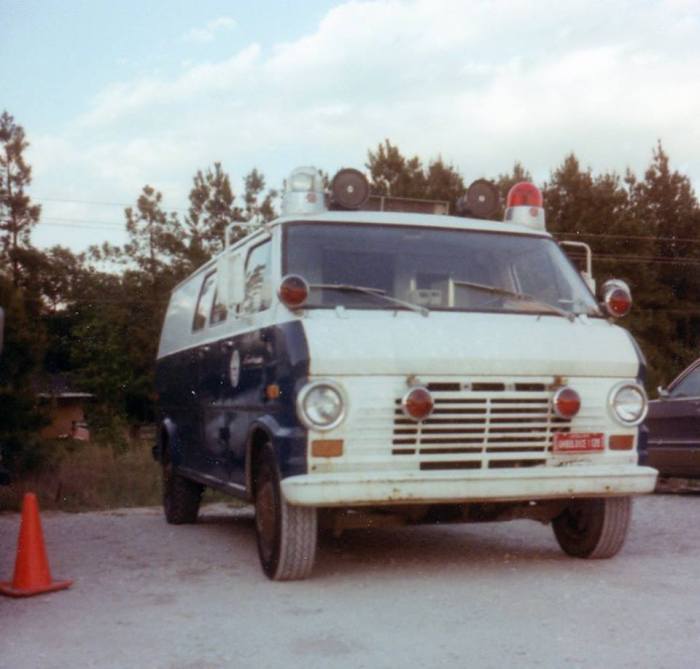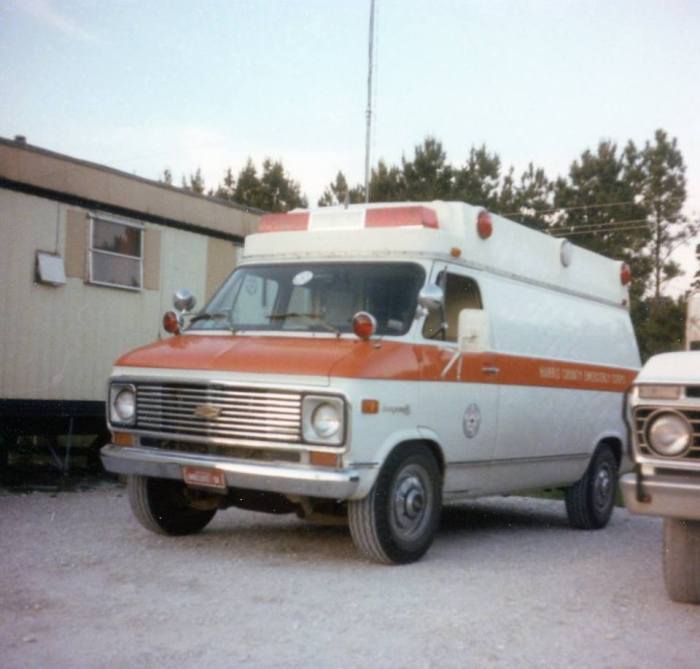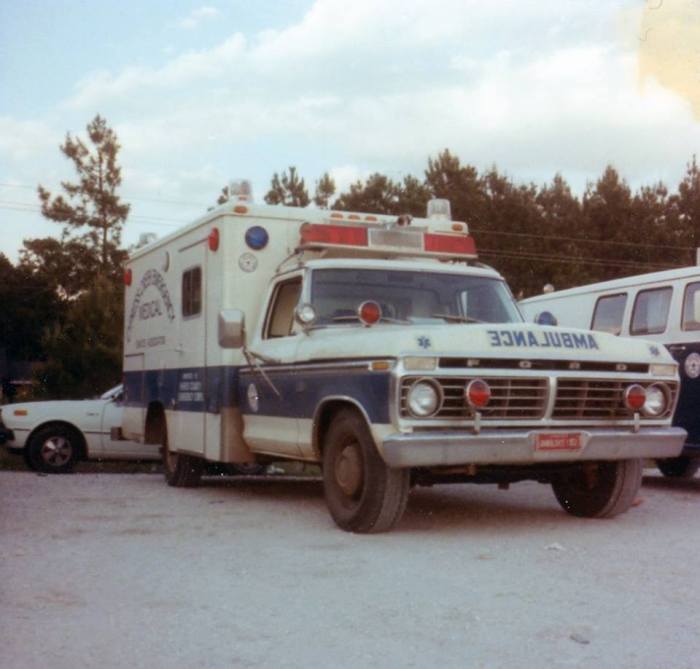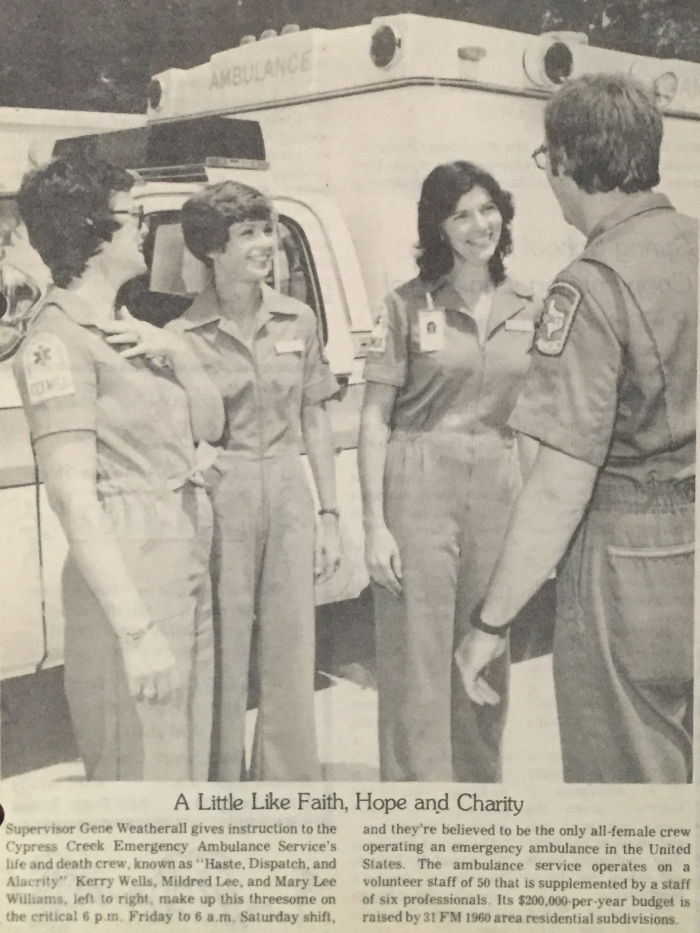History of Cypress Creek EMS
Introduction
Cypress Creek EMS (CCEMS) began in 1975 through ideas, commitment, dedication, and hard work by a small group of visionary volunteers who were displeased with the lack of dependable emergency medical services in the FM 1960 area of north Harris County, Texas. Their vision became action when an area resident died of a heart attack when EMS care wasn’t available on a timely basis. Since that time, CCEMS has continued to grow, innovate, and re-invent itself with the introduction of ever more effective methods of care as calls for service continually increase.
Exceptional EMS care
North Harris County residents are very familiar with the gleaming red and white vehicles that bear the proud crest of Cypress Creek Emergency Medical Services and the Paramedics and EMTs in their distinctive red uniform shirts. Each of our units is a Mobile Intensive Care Unit, licensed by the State of Texas, fully equipped to provide the highest standard of prehospital emergency care. The highly trained, skilled Paramedics and EMTs (Emergency Medical Technicians) on each unit have completed rigorous, initial, and continuing education to effectively respond to any emergency medical situation they encounter while on duty. Today, CCEMS typically arrives on the scene in about 8 minutes providing an exceptional level of emergency care to more than 550,000 neighbors in a 177 square mile area.
In the beginning – 1975
FM (Farm to Market) 1960 was a two-lane road, and the nearest shopping center was miles away. “Dining Out” meant a road trip into Houston. Fortunately, a new local hospital (Houston Northwest Medical Center) was built and staffed, providing the growing population a wide range of medical services close to home. At the time, the Wall Street Journal called the “1960 Area” the fastest growing residential community in America.
Thousands of people continued to move into the quiet, wooded area during Houston’s energy and aerospace population boom, but the availability of prompt, high quality emergency medical care was overlooked. Response times to medical emergencies routinely exceeded an hour.
A single event provided the impetus for action by concerned volunteer citizens to provide local dependable Emergency Medical Service. A man had a heart attack. Anxious family members called for help!
They waited in vain for an ambulance as the heart attack victim died in the arms of his wife. A dedicated husband, father and community leader lost his life because there was no emergency team to come to his aid. His needless death provided major concern and stimulus for providing local EMS; first on the street where he lived, then in his subdivision; then throughout north Harris County.
The need for prompt quality care resulted in the service available to us today! and CCEMS has become a national leader in cardiac care.
The Cypress Creek Emergency Medical Services Association was officially chartered by the state of Texas as a non-profit corporation on July 25, 1975.
The following is an attempt to boil down the voluminous history records of Cypress Creek EMS into a relatively short, reader-friendly article that tells the story of CCEMS. Some of the information and pictures for this article comes from a lengthy record written in 2009 by a “History Task Force” composed of the following people who served as volunteer medics and , later on, as CCEMS Board Members … Bill Carey, Jim Cravens, Dave King and Bill Streidl. There is also information and pictures from a 1995 history written by Barbara Payne who handled Public Relations for Cypress Creek EMS in the 90’s and was the first president of ESD#11 after it was approved by voters in 2004.
1975 -THE BEGINNING
In 1975, the vast rural area about 30 miles north of Houston was lush with woods and little else except for the celebrated Champions Golf Club – a beacon that lured golfers from the city and sparked home building in the area. A two-lane, blacktop farm to market road (FM 1960) was well on its way to becoming one of the busiest and most dangerous thoroughfares in Texas.
Houston Northwest Medical Center opened its doors in 1973, but there was no reliable EMS service until CCEMS was born two years later. Cypress Creek EMS was given life by a fatal heart attack. On November 9, 1974, Cypresswood resident Dick Eckert died waiting for an ambulance. Eckert, an engineer at Brown and Root, was just 48 years old.
In those days emergency medical services, when available, were privately owned for the most part and lacking in the most basic of care. It was just “load and go” if they even showed up.” Callers with emergencies might be greeted with messages asking them to leave their name and number; or worse, “The number you have reached is no longer in service.” And, of course, there was no 9-1-1 service at the time.
SYMPATHY PAIN
Cypresswood residents Cliff and Kati Woodward (pictured below in 2016) along with Mike and Nancy Maxwell were saddened by Eckert’s death and were determined to do what they could to prevent another neighbor from dying while waiting for an ambulance. They created a volunteer ambulance service and organized a five-member committee. The committee members realized they would need money, personnel, training and, of course, ambulances to deliver emergency medical care.
KATI WOODWARD REMEMBERS
Editor’s note: Following Dick Eckert’s death, his widow decided to move back to their home state of Illinois. She held a garage sale to sell off the belongings she did not intend to take with her. What follows is co-founder Kati Woodward’s story about how that garage sale played a prominent role in the creation of CCEMS. Kati also got some historical input from her husband, Cliff.
“Hollie Harrow, an avid garage sale goer, spoke to Mrs. Eckert at her sale, then came and told me. I told Cliff, who was the civic club president at that time. He talked to Joe Reynolds, the past president. Joe said to contact Mike Maxwell since he had been in the medical corps in the Army and would know a lot. So, Cliff contacted Mike.
They decided that Mike would handle all of the medical issues, like types of ambulances, supplies, types of certifications, etc. The Houston Fire Department was just starting up their ambulance service so that publicity helped us in making some decisions. An example of that is the type of ambulance to buy. The big ones, like the kind we have now, had just come out, so that type was our goal.
Cliff was going to do the other part: create an organization to fund the service and get volunteers and paid staff. He went around to the major subdivision civic clubs and told the residents the story about Dick Eckert. They were flabbergasted and came on board quickly.
After a meeting at Ponderosa William Smith, the executive director of Herman Hospital, came up and talked to Cliff. He told Cliff that Dr. (Red) Duke had been bugging him to start a helicopter ambulance service and that he had been on the fence about whether to proceed. Smith told Cliff, “After hearing you speak tonight, I’m going to do it.” (Life Flight began operations the following year in 1976)
We set up first responder teams in various subdivisions. They learned basic first aid and were called when the dispatcher got an emergency call. One came to the house behind us when a 3-year-old fell in the pool. It was the day before Mother’s Day. First responders lived across street from them and were there immediately. The next morning he woke up and said “Mama”, so we knew he was going to be okay.”
David Livingston was the attorney who set up our 501(c)(3) and took care of all other legal issues. He was a young lawyer and was a dedicated board member and so helpful. I wrote the By-Laws and named it Cypress Creek Emergency Medical Services Association. I based this name on what connected such a big area.”
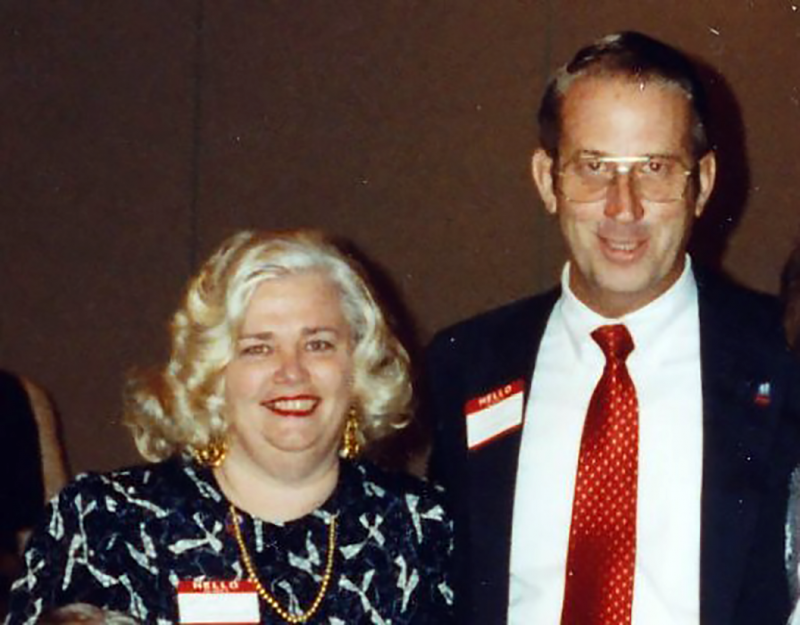
Kati and Cliff Woodward
CLIFF WOODWARD REMEMBERS
In the early days of CCEMS, founder Cliff Woodward spent a lot of time fundraising. He recalls that he was giving a talk to the residents of Ponderosa one night with the goal of getting each household to pledge regular donations. Afterward, a man walked up to him and introduced himself as the CEO of Memorial Hermann. Cliff recalls that the man said that “Dr. Duke has been bugging me to start a helicopter ambulance service. After hearing you speak tonight, I’m going to do it.” Life Flight went into service in 1976. According to the history of Memorial Hermann, the CEO at that time was, William F. “Bill” Smith.
ON THE MOVE
As you’ve read in Kati’s recollections, CCEMS turned to homeowners for funding in the beginning. During a Cypress Creek United Civic Association meeting held at the Cypresswood Clubhouse attended by representatives from 20 subdivisions, the board asked each family to donate $25 to fund operating expenditures for an ambulance, equipment, and personnel.
There – in an era when ambulance crews took care instructions over the phone and radio from emergency rooms and administered very few medications – was born Cypress Creek EMS. Its birth name was Cypress Creek Emergency Medical Services Association and it was based on the geographic feature that tied all of the coverage area together.
CCEMS fundraising kicked-off on July 19, 1975. John Turner, the treasurer, made a first-day deposit of $8,382. Funding came strictly from individual donations. Later, water districts collected from supportive donors, community partners held fundraisers such as bake sales. CCEMS volunteers hit up neighbors for annual commitments and grateful residents sent cash-stuffed notes of thanks for the care their loved ones received.
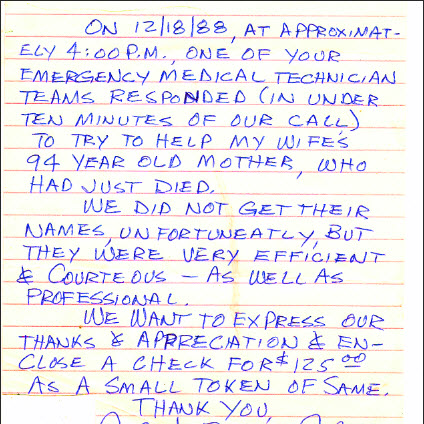
One note from Dick Eckert’s widow, Sheri, was particularly meaningful.
“The sadness of death stems from a fact of life; namely, that human life draws its richness and fullness from the quality of the human relationship that makes it up. When a friend or loved one dies, the human relationship no longer exists in the same way. And, that is immeasurable, sad. Death is usually an ending; the smile is gone, the laughter is silenced, the call, the voice, the wisdom stilled. In Dick’s case, it was different. He might have been saved if CCEMSA existed. Dick died. We hoped that this would be a lesson that would allow others to live. Out of the sadness of his death was born the joy of CCEMSA.”
CCEMS was officially incorporated in 1975. The articles of incorporation were signed by Texas Secretary of State Mark White on July 25, 1975. White would later serve as Governor of Texas.
Beginning in June 1975, the committee contracted with the Harris County Emergency Service Corps to operate the service along with Cypress Creek volunteers. HCESC ran calls during the day when volunteers were at their day jobs and volunteers ran calls at night when they got off work. In March 1977, CCEMS split from HCESC over differences of opinion on how the service should be run. Stay-at-home moms volunteered and started training so they could run ambulance calls during the day while their children were in school. It is believed that Cypress Creek EMS had the only all-female medic team in the country in 1977, as detailed in this newspaper item.
While CCEMS enjoyed strong support from some scattered across the area, the road to funding was bumpy in the beginning, with volunteers often paying for gas and supplies out of their own pockets. A 1976 Houston Post article quoted an associate professor from the University of Texas School of Public Health, who said he was “frankly appalled” at the apathy among some residents.
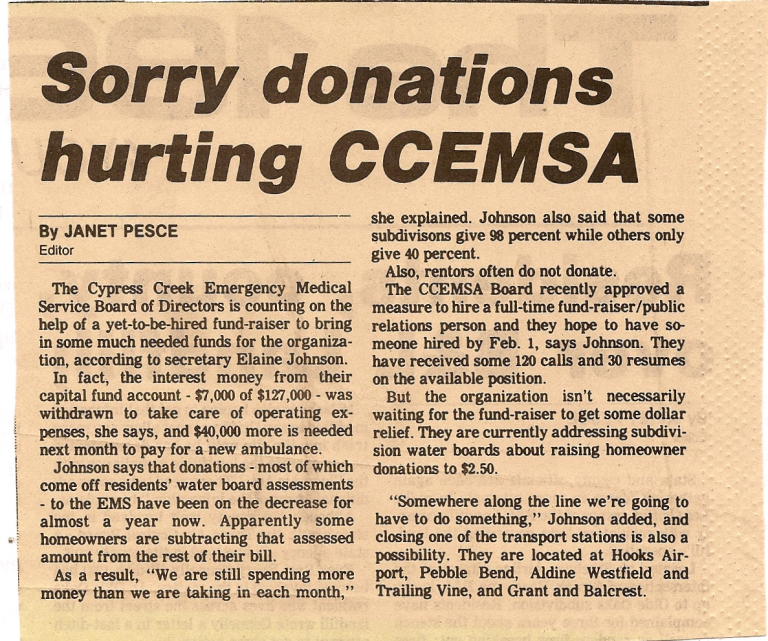
Fundraising that first year cultivated $110,000 from about 5,000 contributors. In 1976, the door-to-door fundraising goal was $210,000.
EARLY ORGANIZATION
CCEMS’ first by-laws were adopted September 3, 1975. Five citizens co-signed a $25,000 note with General Electric Credit for seed money. The Kiwanis meeting room at Sambo’s at FM 1960 and Kuykendahl served as the first crew quarters. It included breakfast for the on-call volunteer crew. Later, the crew met in Northwood Presbyterian’s first-grade meeting room at FM 1960 and T.C. Jester, where they negotiated pint-sized tables, chairs, sinks, and toilets.
The first CCEMS station opened in an old, drafty mobile home which was placed behind Houston Northwest Medical Center, a top-ranked hospital with which CCEMS still enjoys a close relationship.
On December 14, 1975, the first ambulance bearing the name “Cypress Creek EMS” arrived and was put into service.
PIONEERING EMS PROTOCOLS
The first formal board was formed in 1976. Bob Baker was elected president and Gene Weatherall was hired as director of services. He was CCEMS’ first paid employee. Weatherall is considered to be one of the early pioneers of Emergency Medical Services in Texas and would go on to serve as Chief of the Texas Bureau of Emergency Management, where he set state standards for EMS and oversaw the testing and certification of the state’s EMTs and Paramedics.
In the mid-’70s through the early ‘80s, EMS was in its infancy in Texas, lacking substantive practices, regulations, and laws. Some for-profit ambulance services of the day were flatly and boldly running amuck. Early CCEMS staff and volunteers, including Jim Cravens, Dave King, Toivo Sari and Jim Van Hooser, recalled many incidents that ranged from unethical to illegal.
At the time, they say private ambulance services literally tried to run CCEMS ambulances off the road. Tires were slashed, sugar was poured into ambulance gas tanks, and CCEMS crews were egged. If a private ambulance got to a scene first the crew quickly tossed patients onto a stretcher to keep them away from CCEMS, a practice that was clearly dangerous for any patient with a potential spine injury.
CCEMS volunteers contacted legislators with their concerns, which ultimately evolved into best practices, regulations, and laws for emergency medical services in Texas. Charlie Hooks, John Musick, and Kerry Wells were among the first paid medics. Kerry Wells was the first woman hired by CCEMS and was also one of the first woman firefighters with the Klein Volunteer Fire Department. Her extensive community involvement was recognized over the years and she received the prestigious “Citizen of the Year” award from the Houston Northwest Chamber of Commerce.
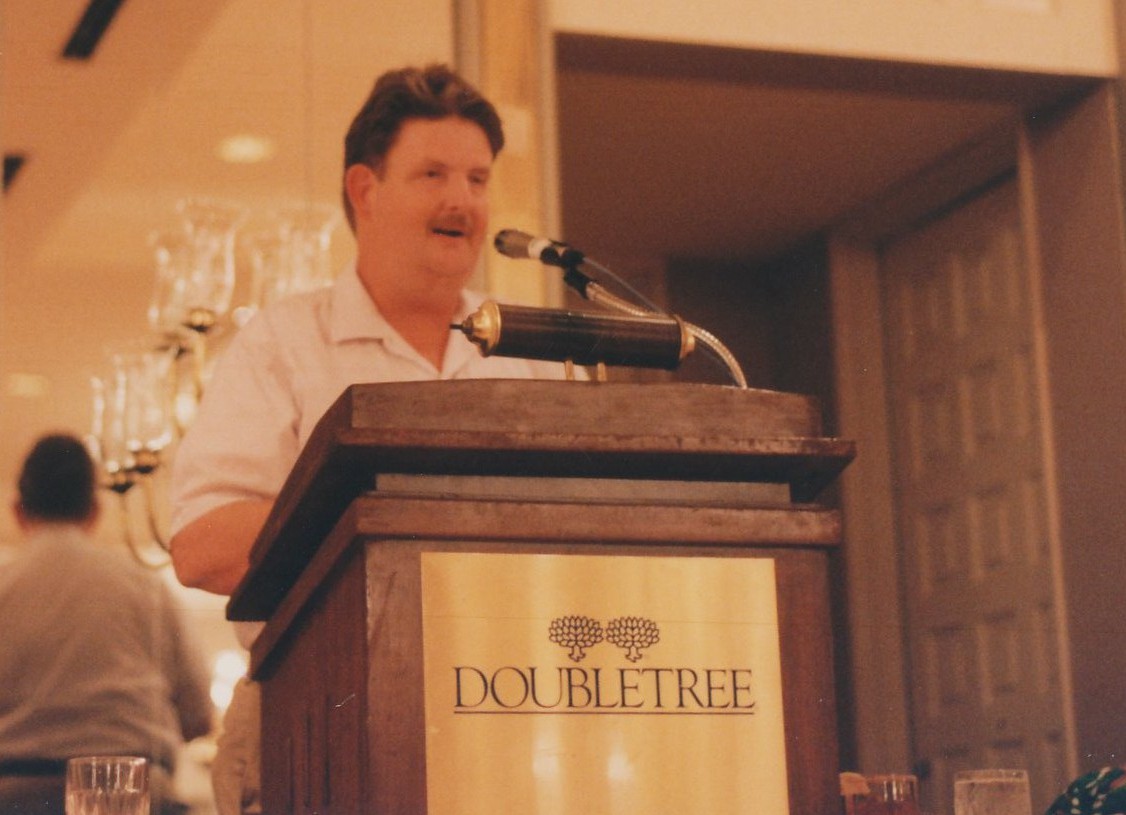
Charles R. Hooks
EARLY MEDIA COVERAGE
A 1976 article in The 1960 Sun reported that 17 CCEMS staff members had become certified medics and characterized Houston Northwest Medical Center as eager to cooperate in the training. The story reported a monthly call load that August of 170, more than double the count over the previous year. The average response time was a respectable 10 minutes.
BUILD IT AND THEY WILL COME
Explosive development in the northern portion of Harris County started driving CCEMS’ expansion in the late ‘70s. Cypress Creek EMS wasn’t alone. Various school districts and other branches of government also were starting to face the challenge. CCEMS opened its second station in 1976 at FM 1960 and FM 149, now Texas 249. By 1980, CCEMS was operating three stations around-the-clock. Ground was broken for a more permanent home for Station 3 in 1986.
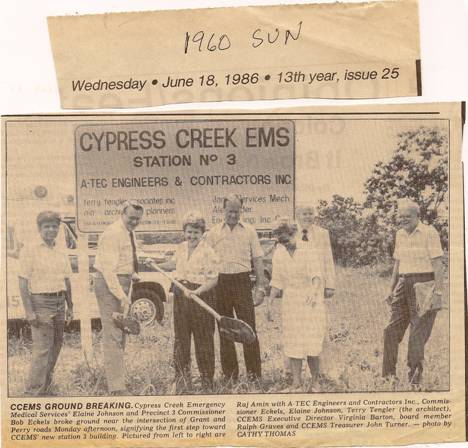
In January 1980, CCEMS relocated its central facilities to a new, 1,500-square-foot site at Olde Oakes Park on Pebble Bend Drive in an effort to centralize its dispatch and operations geographically and reduce response times. By then, the organization had more than 100 volunteers – including airline pilots, doctors, and stay-at-home-moms. Volunteers assisted in the construction of the new site and purchased their own uniforms.
In 1981 monthly calls for services jumped by 50 percent to 339 calls and CCEMS opened its first satellite stations, one on Grant Road and the other on Aldine Westfield.
In 1985, CCEMS opened its new headquarters on Sugar Pine, which also housed the FM 1960 Area Emergency Communications Center, handling 911 calls and dispatch for CCEMS, North Harris County Volunteer Fire Departments, and the Harris County Sheriff’s Office.
The operation handled some 9,000 calls a year, directing ambulances to Houston Northwest Medical Center as well as hospitals in Cy-Fair, Tomball, and Kingwood.
Today, the Cypress Creek EMS Communications Center handles 9-1-1 calls and dispatch for 15 other emergency agencies. The Comm Center handled more than 58,000 calls in 2014 and nearly 67,000 calls in 2015. By 2017, the totals topped 90,000. More than 44,000 of those were for EMS.
CCEMS INNOVATION AND RECOGNITION
CCEMS was named the top EMS system in the nation in 1986 by the National Association of Emergency Medical Technicians.
In 1999, Dr. Levon Vartanian, an ER physician at Houston Northwest Medical Center and a former paramedic, became the Medical Director of CCEMS. He immediately began introducing “advanced EMS protocols”, ultimately delivering to the community the most educated paramedics in the field, administering some of the most advanced emergency pre-hospital care in the country.
In May 2015, the American Heart Association recognized Cypress Creek EMS with a Gold Award for its treatment of patients with the most dangerous and life-threatening type of heart attack, known as a STEMI or ST Elevation Myocardial Infarction. Cypress Creek was the only EMS service to achieve Gold status in the Greater Houston area was also the only Gold Award winner on the entire Texas Gulf Coast in 2015. In 2018, CCEMS was awarded a Gold Plus recognition.
In 2006, Cypress Creek EMS pioneered a new medical protocol for STEMI patients spearheaded by our Medical Director, Dr. Levon Vartanian. It was the first such program ever attempted in the Greater Houston area and we have not been able to find a record a similar program existing in Texas or the Nation at that time.
A STEMI means there is a blockage in one of the coronary arteries. The sooner the blockage can be cleared, the better the chances of survival. Faster treatment also reduces the chance of serious damage to the heart muscle or even brain damage from lack of oxygen, leading to a better quality of life for survivors.
Dr. Vartanian, his clinical staff, and the cardiology team at Houston Northwest Medical Center trained lead CCEMS Paramedics to read and interpret 12 lead Electrocardiograms, also known as EKGs or ECGs, allowing them to recognize patients suffering from a life-threatening STEMI event in the field. CCEMS Paramedics consistently get 98% to 100% correct in our monthly statistics.
After a STEMI event is confirmed by the EKG, Cypress Creek EMS paramedics initiate treatment in the ambulance that would normally occur in the emergency room. Then, the hospital is alerted so the patient can bypass the emergency room and be taken straight to the heart catheter suite, where an interventional cardiologist performs a procedure to clear the blocked coronary artery. This involves inserting a catheter into the upper thigh or lower wrist and carefully snaking it through an artery to the blockage in the heart, where a small balloon is inflated to clear the blockage and insert stents to keep the vessels open and restore normal blood flow.
The national goal established by the American Heart Association is to get such a patient from the hospital door to balloon inflation in 90 minutes. Since CCEMS begins care in the ambulance and bypasses the emergency room, our “hospital door to inflation” time is an average of about 50 minutes. This takes into account the “middle of the night” cases where an on-call cardiology team is called in from home.
Even the CCEMS time from the scene to inflation is under the national standard at just 86 minutes and from the 9-1-1 call to balloon inflation is an average of 97 minutes. This innovative medical protocol was established in June of 2006 in cooperation with Houston Northwest Medical Center but is now standard practice for all of the hospitals within the Cypress Creek EMS service area.
Due to its success, our STEMI Alert protocol has been replicated across the state and nation. In the early days of the program, the American Heart Association invited Cypress Creek EMS to present data on our STEMI alert program at several scientific conferences in an effort to establish the program in more locations.
CCEMS was the first in Texas and among just four EMS Agencies nationally to use automated CPR devices which deliver more consistent compressions. In fact, the CCEMS had to wait on the deployment of the Lucas Chest Compression Device until it was approved by the FDA.
CCEMS was also one of the first in our area to induce hypothermia through chilled I.V. fluids to further protect the heart muscle and brain of cardiac arrest victims. With these and other innovations, CCEMS greatly improved the survival rate of heart attack victims. Nationally the ROSC (Return of Spontaneous Circulation) rate is around 26% upon hospital arrival. Thanks to its groundbreaking innovations CCEMS increased its ROSC rate to nearly 50%, meaning patients arrive at the hospital with a restored heartbeat.
All this innovation did not go unnoticed. The Texas Department of State Health Services recognized Dr. Levon Vartanian as Texas Medical Director of the Year in 2009 and again in 2011. TDSHS also recognized Cypress Creek as the EMS Provider of the Year in 2011.
In 2016, CCEMS became one of only two ground EMS systems in the country to carry blood products in the field and in 2017 CCEMS transitioned to whole blood along with partner Harris County ESD 48 Fire/EMS in the Katy area. Cypress Creek EMS was the first civilian EMS ever to transfuse whole blood into a trauma patient in the field.
SPECIAL OPERATIONS TEAMS AND TRAINING
CCEMS also is recognized nationally and internationally for its Tactical EMS team. The vision for the team was conceived in 1994, in part as a result of the disastrous loss of life at the 1993 Branch Davidian siege. The team, whose members are tactical paramedics and licensed police officers went into action in 1997 and have since worked alongside local, state and federal authorities in active shooter situations and high-risk arrests. The team is there to provide medical care to injured law enforcement officers and injured bystanders in the line of fire, if necessary. The FBI has twice recognized members of the CCEMS team with honors for its work, including its assistance during a hostage rescue.
Police officers, medics and doctors now come to CCEMS from around the world for our Tactical Medic Training which is held twice a year and is recognized as one of the best in the world. In fact, it’s the only such training officially approved by the government of Canada. The Canadian government has approved two such programs… ours and theirs. The techniques taught in the class have been used to save the lives of civilians involved in vehicle accidents, stabbings, and shootings.
Evansville Police Department officers have saved multiple lives using techniques learned at CCEMS and shared with fellow officers.
CCEMS also was among the first in the country to develop a Bike Medic Response Team, which provides emergency care at crowded events as races, parades, and festivals, where responding with a traditional ambulance is not practical and would take too long. CCEMS is also a leader in teaching new bike medics and bicycle police. Cypress Creek has several employees who are certified by the International Police Mountain Bike Association (IPMBA) as instructors.
EMERGENCY SERVICE DISTRICT CREATED
2004 was a big year. After a public campaign for its support, voters approved the creation of ESD #11 on May 15, providing for a property tax to support Emergency Medical Services. Cypress Creek EMS won the contract from ESD#11 to provide Emergency Medical Service. CCEMS remains a private non-profit corporation and raises almost half of its own budget through ambulance fees, communications fees from the 15 agencies for which the CCEMS Comm Center provides dispatch and educational fees. About 51% of its $20 million budget comes from tax dollars.
NEW HOME
In 2007, CCEMS broke ground on its new six-acre campus. The site houses CCEMS’ administrative headquarters, the Charles R. Hooks Education Center, an EMS station, and the Communications Center – all of which total about 20,000 square feet.
EDUCATION, TRAINING & DEVELOPMENT
The paramedic training program at Cypress Creek EMS is accredited by ABHES (Accrediting Bureau of Health Education Schools) and CoA/CCAHEP (Commission on Accreditation of Allied Health Education Programs).
CCEMS also hosts various courses at its education center for the community, CCEMS staff, and medical professionals from around the country. CPR/AED training and weekly car seat inspections are offered to the public.
LEADERSHIP
Developing a national reputation for innovation doesn’t happen in a vacuum. Over the history of CCEMS, it has taken forward thinking members of the CCEMS Board of Directors, dynamic leaders and a professional team of employees and volunteers. It also helps to be a private non-profit corporation because CCEMS can focus on what’s best for our patients rather than what’s best for the investor’s bottom line.
We believe it is also a plus that many of today’s leaders were promoted from within, having served on the front lines of emergency medical care.
In August 2016, Cypress Creek EMS became just one of two ground EMS systems in Texas and, we believe, the country to transfuse packed red blood cells and fresh plasma in the field. A life was saved by the very first transfusion. In September of 2017, CCEMS made the transition to Whole Blood. CCEMS and partner ESD 48 are the first ground EMS systems in the country to carry and transfuse hole blood in the field.
